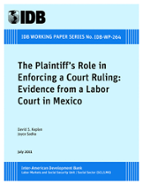The Plaintiff's Role in Enforcing a Court Ruling: Evidence from a Labor Court in Mexico
Date
Jul 2011
We analyze the outcomes of 332 cases from a labor court in Mexico in which a judge awarded money to a plaintiff who claimed to have been fired by a firm without cause. The judgments were enforced in only 40% of the cases. A plaintiff may try to enforce a judgment by petitioning the court to seize the firm's assets when the firm refuses to pay. Thirty eight percent of the enforced judgments required at least one seizure attempt. We estimate the parameters of post judgment games in which the worker does not know if a seizure attempt would ultimately succeed and show that these models explain the data well. We then simulate the effects of a policy that reduces worker costs of a seizure attempt. We find that this policy would increase the probability of enforcement, either by increasing the probability that the worker attempts an asset seizure or by inducing firms to pay voluntarily to avoid such seizure attempts. However, reducing worker costs of seizure attempts can only have a modest effect on enforcement probabilities because a high percentage of firms are able to avoid payment in spite of worker efforts to force collection.



